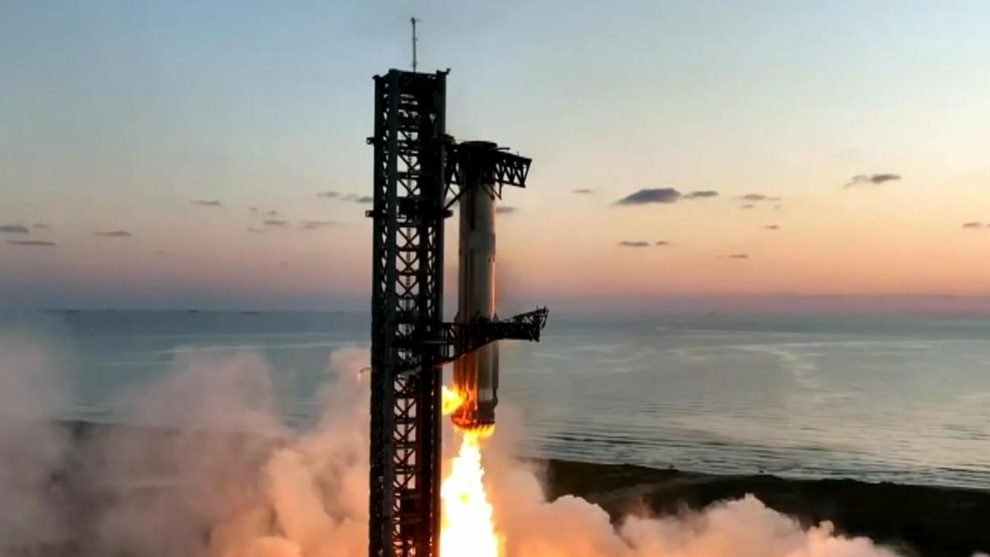SpaceX has once again pushed the boundaries of space exploration. On Sunday, the company’s fifth Starship test flight achieved a milestone that has long been the stuff of science fiction: the successful mid-air capture and return of the massive first stage booster to its launch pad using colossal mechanical arms. This historic feat marks a significant leap forward in SpaceX’s quest for fully reusable spacecraft and brings humanity one step closer to sustainable interplanetary travel.
The test flight, which took place at SpaceX’s Starbase facility in Boca Chica, Texas, was the culmination of years of research, development, and iterative design. The Starship, standing at an imposing 394 feet tall when fully stacked, represents SpaceX’s vision for a fully reusable transportation system capable of carrying both crew and cargo to Earth orbit, the Moon, Mars, and beyond.
While previous test flights had focused on perfecting the launch and controlled descent of the Starship’s upper stage, this mission’s primary objective was to demonstrate the feasibility of catching and safely returning the Super Heavy booster – the largest and most powerful rocket stage ever built – to its launch mount without touching the ground.
SpaceX CEO Elon Musk, known for his ambitious goals and penchant for pushing technological limits, hailed the success as a “game-changer” for space exploration. This is the key to making life multiplanetary,” Musk declared in a post-flight press conference. “By catching the booster with the launch tower, we’re eliminating the need for expensive landing legs and dramatically reducing turnaround time between flights.”
The test flight began at 9:15 AM CDT under clear skies and optimal weather conditions. As the countdown reached zero, the Super Heavy booster’s 33 Raptor engines roared to life, generating over 16 million pounds of thrust and sending the massive rocket soaring into the Texas sky.
At T+2 minutes and 30 seconds, the booster successfully separated from the Starship upper stage at an altitude of approximately 70 kilometers. While the upper stage continued its journey to a planned splashdown in the Gulf of Mexico, all eyes turned to the descending booster.
Using a combination of grid fins for steering and a carefully choreographed engine burn sequence, the Super Heavy booster began its controlled descent back towards the launch site. At T+6 minutes, the booster entered its final approach, aligning itself with the launch tower’s outstretched arms.
In a heart-stopping moment that lasted mere seconds, the tower’s massive mechanical arms – dubbed “chopsticks” by SpaceX engineers – smoothly swung into position, gently grasping the falling booster by its hardpoints and bringing it to a graceful halt. The precision required for this maneuver cannot be overstated; the booster, weighing over 200 tons and moving at considerable speed, had to be caught within a window of less than a meter.
As the dust settled and the booster was lowered onto the launch mount, cheers erupted from SpaceX mission control and the gathered crowd of space enthusiasts. The seemingly impossible had been achieved, and a new chapter in spaceflight history had been written.
The successful mid-air capture of the Super Heavy booster was made possible by a suite of cutting-edge technologies and innovations. At the heart of this achievement is the launch and catch tower, affectionately nicknamed “Mechazilla” by SpaceX employees.
Standing at 469 feet tall, the tower is equipped with two massive mechanical arms capable of both lifting the fully stacked Starship onto the launch mount and catching the returning booster. These arms, each measuring 360 feet long, are powered by hydraulic systems that allow for precise control and rapid movement.
The booster itself is outfitted with specially designed hardpoints that serve as connection points for the tower’s arms. These hardpoints are engineered to withstand the immense forces involved in the catch maneuver while also allowing for quick release during launch preparations.
A sophisticated array of sensors, cameras, and real-time telemetry systems work in concert to guide the booster’s descent and align it perfectly with the waiting arms. Machine learning algorithms process this data at lightning speed, making minute adjustments to ensure a successful capture.
Dr. Jane Foster, an aerospace engineer not affiliated with SpaceX, described the complexity of the operation: “What we witnessed today is akin to threading a needle while both the needle and the thread are moving at high speeds. The level of precision and coordination required is simply staggering.”
The successful demonstration of the booster catch technique has far-reaching implications for the future of space exploration and commerce. By eliminating the need for traditional landing legs and the associated ground infrastructure, SpaceX has potentially solved one of the key challenges in developing a rapidly reusable heavy-lift rocket system.
1. Reduced Turnaround Time: With the booster returned directly to its launch mount, refurbishment and preparation for the next launch can begin immediately, dramatically reducing the time between flights.
2. Lower Operational Costs: The elimination of landing legs and the reduced wear and tear on the booster from traditional landings could significantly decrease maintenance costs and extend the operational life of each booster.
3. Increased Payload Capacity: Without the weight of landing legs, the Starship system can potentially carry even more cargo to orbit, enhancing its effectiveness for both Earth-orbit missions and deep space exploration.
4. Improved Launch Site Flexibility: The catch system could potentially be adapted for use at various launch sites, including offshore platforms, expanding the range of possible launch locations.
Dr. Sarah Chen, a space policy expert at the University of California, Berkeley, commented on the broader implications: “This successful test brings us one step closer to Musk’s vision of a city on Mars. More importantly, it demonstrates that with innovative thinking, we can overcome seemingly insurmountable challenges in space exploration.”
While the success of this test flight represents a major milestone, SpaceX engineers are quick to point out that there is still much work to be done before the Starship system is ready for operational missions.
One of the key challenges moving forward will be demonstrating the reliability and repeatability of the booster catch maneuver under various conditions. Future tests will likely focus on perfecting the technique in different weather scenarios and with varying payload configurations.
Additionally, the company will need to prove the durability of both the booster and the catch system over multiple flights. The extreme forces and temperatures involved in rocket launches and landings put immense stress on materials and components, and ensuring consistent performance over many missions will be crucial.
SpaceX has also announced plans to attempt a full catch and relaunch of both the Super Heavy booster and the Starship upper stage in future tests, aiming to demonstrate true rapid reusability of the entire system.
The success of SpaceX’s latest test has sent ripples through the aerospace industry, eliciting reactions from competitors, government agencies, and industry analysts alike.
NASA Administrator Bill Nelson praised the achievement in a statement: “SpaceX’s innovation continues to push the boundaries of what’s possible in spaceflight. This successful test bodes well for our Artemis program and the future of human space exploration.
Competitors in the commercial space industry have taken note as well. Blue Origin, founded by Amazon’s Jeff Bezos, released a statement congratulating SpaceX while reaffirming their own commitment to developing reusable launch systems. “Today’s achievement by SpaceX is a win for the entire industry,” the statement read. “It proves that bold ideas in space technology can become reality.”
Industry analyst Maria Gonzalez of Space Capital Partners noted the potential economic impact: “If SpaceX can achieve rapid reusability at the scale of Starship, we could see a fundamental shift in the economics of space access. This could open up new markets and accelerate the development of space-based industries.”
As the space industry continues to grow, concerns about its environmental impact have gained increasing attention. SpaceX claims that the Starship system, when fully operational, will actually have a lower environmental impact per launch than smaller, expendable rockets.
The company argues that the full reusability of Starship, combined with its use of methane fuel – which can be produced using renewable energy and carbon capture techniques – could make it one of the most environmentally friendly launch systems ever developed.
However, some environmental groups have expressed concern about the increased launch cadence that Starship could enable. Dr. Michael Green, an environmental scientist specializing in atmospheric effects of rocket launches, cautioned: “While reusability is certainly a step in the right direction, we need to carefully study the cumulative impact of more frequent launches on our atmosphere and ecosystems.”
SpaceX has stated its commitment to working with environmental agencies and researchers to monitor and mitigate any potential negative impacts of its operations.
With this successful test flight, SpaceX has taken a giant leap towards realizing its vision of making humanity a multi-planetary species. The company has already secured several high-profile contracts for Starship, including NASA’s selection of the vehicle for the Artemis program’s human landing system on the Moon.
Elon Musk has outlined an ambitious timeline for Starship’s future milestones:
– Orbital test flight with full stack recovery by the end of the year
– Uncrewed cargo missions to Mars within the next three years
– First crewed mission to the Moon as part of NASA’s Artemis program by 2025
– Establishment of a permanent human presence on Mars by 2030
While these goals may seem overly optimistic to some, SpaceX has a track record of achieving what many once thought impossible. The successful capture of the Super Heavy booster is a testament to the company’s innovative spirit and engineering prowess.
As humanity stands on the brink of a new era in space exploration, the implications of SpaceX’s achievement extend far beyond the realm of aerospace engineering. The ability to reliably and efficiently access space could revolutionize fields ranging from telecommunications and earth observation to asteroid mining and deep space research.
In the words of Dr. Elena Rodriguez, a historian of space exploration at MIT, “Today’s test may well be remembered as a pivotal moment in human history – the day we truly began to reach for the stars.”
As the sun set on Starbase that Sunday evening, the caught booster stood tall on its launch mount, a silent testament to human ingenuity and a harbinger of the incredible journey that lies ahead. The road to making life multi-planetary is long and fraught with challenges, but with each successful test, that once-distant dream inches closer to reality.
















Add Comment